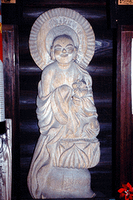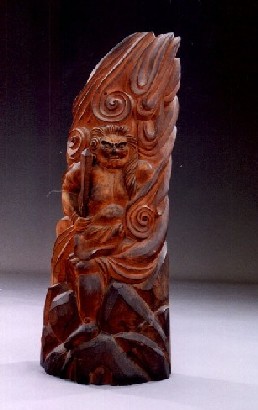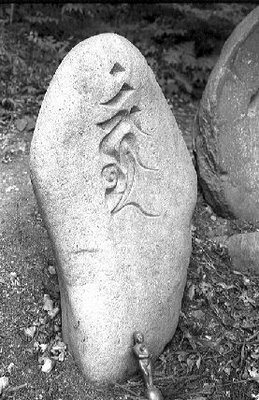:::::::::::::::::::::::::::::::::::::::::::::::::::::::::::::::::::::::::::::::::::::::::::::::::::::::::::::::::::::::::::::::::::::::::::::::::::::::::::::::::::::::::::::::::::::::::::::::::::::::::
木喰 The Mokujiki Priests of Japan
Mojujiki "eating wood" is a general term for a severe ascetic practice of Buddhist monks and priests.
mokujikikai 木食戒 mokujiki kai, vow (commandment) to eat "only wood"
The vow is not to eat grains any more (kokudachi 穀断ち ), 断穀行
五穀断ち not eating five sorts of grains / / 十穀断ち not eating ten sorts of grains
The aim of this ascetic practise is to become a
. sokushinbutsu miira 即身仏のミイラ / 肉身仏 living mummy asceticism .
:::::::::::::::::::::::::::::::::::::::::::::::::::::::::::::::::::::::::::::::::::::::::::::::::::::::::::::::::::::::::::::::::::::::::::::::::::::::::::::::::::::::::::::::::::::::::::::::::::::::::
Saint Mokujiki 木喰上人 / 木食 statue carver
Mokujiki Myooman 木食明満 Mokujiki Myoman / Mokujiki Gogyō 木喰五行 Gogyo
(1718 - 1810)

source : fr.wikipedia.org
:::::::::::::::::::::::::::::::::::::::::::::::::::::::::::::::::::::::::::::::::::::::::::::::::::::::::::::::::::::::::::::::::::::::::::::::::::::::::::::::::::::::::::::::::::::::::::::::::::::::::
Saint Mokujiki and his Fudo 木喰の不動さま

source : tabino.sakura.ne.jp
Saint Mokujiki was born in Marubatake in 1718.
He converted to Buddhism when he was 22 years old, and received his ordination with the name Mokujiki at the temple Rakanji in Tokiwa at the age of 45.
Mokuji underwent a type of severe ascetic training that does not allow the consumption of grains, fish, boiled food and salt. He kept to the rules of this training for his entire life.
He went on a pilgrimage throughout Japan until he was 93, and carved more than 1000 Buddist images during this time.
In his old age,
when he had passed 80 years, he realized that people need something kind and gentle to become kind themselves.
「みな人の心を丸くまんまるに どこもかしこも丸くまん丸」
"Peoples hearts need to be all round,
everything needs to be all round and smooth!"
He then started carving Buddha statues with the special smile on their faces, for which he is now so famous. The smile and roundness makes his statues so different from the ones of his fellow Enku.

Smiling Guardian Deity for the People, Mori Town - Renge-Ji
Marubatake 丸畑 Kitagawa Minobu-Cho Minamikoma-Gun Yamanashi
Click HERE to look at more of his Fudo statues !!!!!
.......................................................................

(Jizō Bosatsu 地蔵菩薩)
Please read this extensive article and come back :
. And Mokujiki’s smile revealed true beauty to Yanagi Sōetsu Muneyoshi .
François Macé
Mokujiki 木喰 (1718-1810) and Enkū 円空 (1632-1695)
:::::::::::::::::::::::::::::::::::::::::::::::::::::::::::::::::::::::::::::::::::::::::::::::::::::::::::::::::::::::::::::::::::::::::::::::::::::::::::::::::::::::::::::::::::::::::::::::::::::::::

Exhibition at Isetan 2009 - Enku and Mokujiki
..............................................................................................................................................

CLICK to see more of his 薬師如来 Yakushi Nyorai statues!
:::::::::::::::::::::::::::::::::::::::::::::::::::::::::::::::::::::::::::::::::::::::::::::::::::::::::::::::::::::::::::::::::::::::::::::::::::::::::::::::::::::::::::::::::::::::::::::::::::::::::

From temple Enzoo-Ji 円蔵寺 Enzo-Ji, Joetsu Town, Niigata
and a statue of 毘沙門天 Bishamonten
木喰上人は、俗姓を伊藤といい、享保3年山梨県に生まれ、22歳で仏門に帰依し、その後45歳で木喰戒(火食を絶ち、五穀をさける)を受け、92歳でこの世を去るまで、5度の日本回国を行いました。
この仏像は、文化3年円蔵寺で彫られたものです。上人は、昼、寺に集まる人々の病気や苦悩の相談相手となり、夜は黙々とナタをふるい、一夜に最高3体を刻んだと言われています。
瑞天寺 Suiten-Ji
https://www.city.joetsu.niigata.jp/soshiki/ogata-ku/ogata-miryoku-5-1.html
:::::::::::::::::::::::::::::::::::::::::::::::::::::::::::::::::::::::::::::::::::::::::::::::::::::::::::::::::::::::::::::::::::::::::::::::::::::::::::::::::::::::::::::::::::::::::::::::::::::::::
通力自在不動明王
(木喰上人筆)Writing by Mokujiki, around 1802
The stone is about 90 cm high and 50 cm wide.

不動明王を表す梵字の左側には「日月清明」、右側には「天下和順」の小さな文字がある。
なきがらは いづこのうらに すつるとも みは御嶽に あり明けの月
nakigara wa izuko no ura ni sutsuru to mo mi wa Ontake ni ari ake no tsuki
- source : 長野県の芸術・文化情報センター -
:::::::::::::::::::::::::::::::::::::::::::::::::::::::::::::::::::::::::::::::::::::::::::::::::::::
. 狸谷山不動院 Tanukidaniyama Fudo Temple .
In 1718, Saint Mokujiki practised severe ascetics in the cave here for 17 years.
:::::::::::::::::::::::::::::::::::::::::::::::::::::::::::::::::::::::::::::::::::::::::::::::::::::::::::::::::::::::::::::::::::::::::::::::::::::::::::::::::::::::::::::::::::::::::::::::::::::::::
Mokujiki Ōgo, Mokujiki Oogo 木食應其 / 木食応其 Mokujiki Ogo
(1536 - 1608) 天文5年(1536年)- 慶長13年10月1日(1608年11月8日))
Mokujiki Shonin "wood eating holy Buddhist monk"
A priest of the Shingon sect and scholar of literature.
Also called 深覚坊応其.
A renga poet, living in 近江国 Omi, a member of the 佐々木 Sasaki clan. With his father he fought Oda Nobunaga at the temple 近江観音寺 Kannon-Ji, now in ruins.
In 1573, aged 38, he became a monk at 高野山 Mount Koyasan.
Later he influenced Toyotomi Hideyoshi not to burn the temple at Koyasan.
He was in charge of the funeral for Toyotomi Hideyoshi.

He worked at the temples 応其寺、興山寺、飯道寺 and others.
His famous three-chapter treatiese of renga linked verse is
Mugonshoo, Mugon shō 無言抄 (1603) Mugonsho, Mugon-Sho

Exhibition in Wakayama Museum 和歌山県立博物館
..............................................................................................................................................
. Saint Mokujiki Tanshoo 木喰但唱 Mokujiki Tansho .
and temple 万竜寺 Manryu-Ji, Nagano - around 1611
木食修行, eating only barks of trees and a few vegetables for 1000 days.
and
his disciple Mokujiki Kansho 閑唱上人
..............................................................................................................................................
Mokujiki Gikoo Soojoo 木食義高僧正 Mokujiki Giko Sojo
grandchild of 足利義輝 Ashikaga Yoshiteru (1536 - 1565)
In 1710, he founded this temple in Edo :
. Enmanji 圓満寺 / 円満寺 Enman-Ji .
文京区湯島1-6-2 / 1 Chome-6-2 Yushima, Bunkyō ward
Anther priest Mokujiki is related to this temple, in 1819 :
木食の沙門 Mokujiki no Samon -
Odawara no Kanshoo 小田原観正 Kansho from Odawara / 木食上人観正 / 木食観正上人 (1754 -1829)
木食円満寺江着任候 観正僧正 / / 観正行者
Kansho was born to a fisherman family in 淡路島 Awaji Island (Hyogo) and later active in Odawara.
It seems Kansho was very popular "with men and women, with young and old".
In 1784, when he was 30 years old, 木食観正 traveled all around Japan to hold serviced for the dead, prayed for rain and good harvest and the wellbeing of the farmers. But it seems he also collected a lot of money on this trip.
He came back to Edo. In March 1829 there was a great fire in Edo, which was blamed on the bad prayers of Kansho. So he was taken to prison and put to death by 寺社奉行 the Magistrate of Temple and Shrine Affairs, but it is not clear what crime he was charged with. He died in prison in June.

- reference : fujimizaka.wordpress.com -
Memorial stone of Mokujiki Kansho in Mishima (Shizuoka)
where he stayed in 1819,

source : city.mishima.shizuoka.jp
Memorial stone of Mokujiki Kansho in Saitama
in the compound of temple 三学院. Erected in 1821.
The round top shows the 大日如来の種子 seed syllable for Dainichi Nyorai.
Kansho visited the town of 蕨 Warabi in 1820.

source : city.warabi.saitama.jp

近世の遊行聖と木食観正
西海賢二 Nishikai Kenji (1951 - )
近世の遊行聖である木食観正上人をはじめ徳本上人ら二〇余名の民間宗教者の活動を解明。彼らと、村落内部に多数存在した講集団はどのような関係にあったのか。信仰的社会集団である講集団と遊行聖の実態を探り出す。
Ⅰ= 近世遊行聖研究の課題と方法(課題と方法??研究史の回顧と展望を兼ねて民俗的世界をみる??〈講集団研究の歩み/一九八〇年代以降の民間宗教者研究/一九九〇年代以降の聖・巡礼研究/聖・巡礼研究の新展開/仏教民俗学への再照射/六十六部研究の新展開〉/近世民間宗教者の特質〈近世民間宗教者と民衆思想/近世民間宗教者と在地修験/近世民間宗教者と身分的社会/近世民間宗教者と身分的周縁〉)
Ⅱ= 木食観正の研究(淡路島における木食観正〈木食観正の出自をめぐって/喜作と百姓一揆/行者喜作の宗教活動/初期木食観正の活動/木食
..............................................................................................................................................
Gyooshoo 行勝 Gyosho (1130 - 1217)
Mokujiki Sankyo 木喰山居 (1657 - 1724)
Mokujiki Yooa 木食養阿 Yoa (? - 1763)
Mokujiki Byakudoo 木食白道 Byakudo (1755 - 1826)
Tokuhon 徳本 (?1758 - 1818)
Nichikan Shonin 日鑑上人 of the Nichiren sect, lived in Chiba, 丸山町 Maruyama Town.
During a drought he sat on top of the hill and prayed for rain and after 2 days it rained indeed.
He then continued his mokujiki asceticism and became a "Buddha in the flesh" 肉身仏 after death.
- source : nichibun yokai database -
:::::::::::::::::::::::::::::::::::::::::::::::::::::::::::::::::::::::::::::::::::::::::::::::::::::::::::::::::::::::::::::::::::::::::::::::::::::::::::::::::::::::::::::::::::::::::::::::::::::::::
BACK TO
Who made Buddha Statues ? - Mark Schumacher
Buddhist Sculptors Gallery
Daruma Pilgrims in Japan
- #Mokujiki -
:::::::::::::::::::::::::::::::::::::::::::::::::::::::::::::::::::::::::::::::::::::::::::::::::::::::::::::::::::::::::::::::::::::::::::::::::::::::::::::::::::::::::::::::::::::::::::::::::::::::::
. Buddha Statues and Japanese Deities .
[ . BACK to DARUMA MUSEUM TOP . ]
[ . BACK to WORLDKIGO . TOP . ]
::::::::::::::::::::::::::::::::::::::::::::::::::::::::::::::::::::::::::::::::::::::::::::::::::::::::::::::::::::::::::::::::::::::::::::::::::::::::::::::::::::::::::::::::::::::::::::::::::::::::::